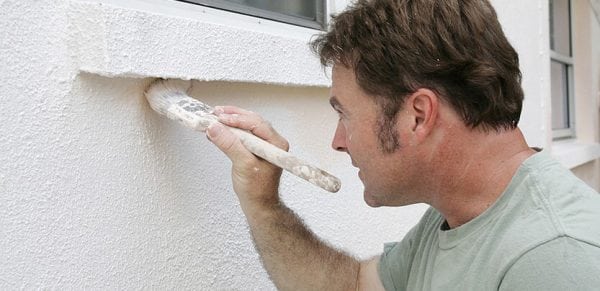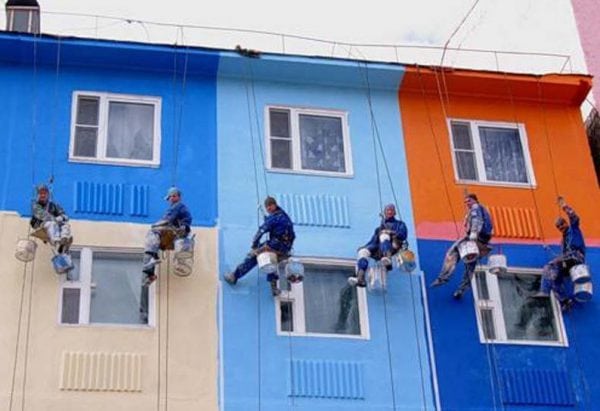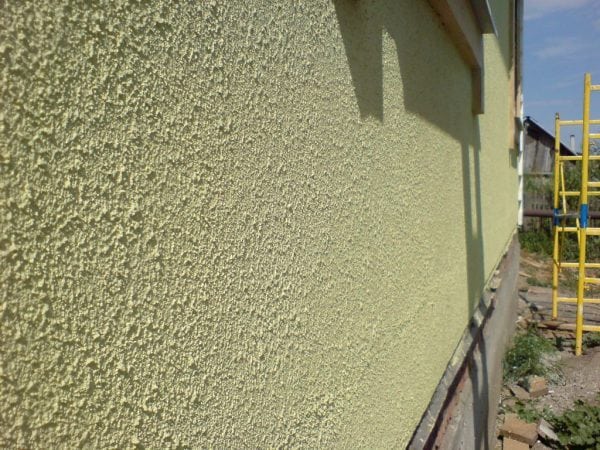To paint the external elements, a special facade paint on concrete is used. Features of its composition provide good adhesion (setting) between the paint and varnish material (abbreviated as LKM) and the treated surface.
- Features of facade paints for concrete
- Types of paints for outdoor use
- The choice of paint for outdoor use
- Application of facade paint
- Paint consumption


Features of facade paints for concrete
The use of facade paints for painting concrete surfaces increases the external attractiveness of structures and increases their service life.
Advantages of paints for outdoor use:
- increased strength;
- resistance to mechanical damage;
- anticorrosive qualities;
- resistance to ultraviolet radiation;
- frost resistance and wind resistance;
- moisture resistance.
Basic requirements for paint for facades:
- Moisture resistant. This is the most important condition, since paintwork on the outside of the structure is constantly exposed to moisture.
- Fire safety. The composition must be resistant to ignition.
- Good adhesive ability. If paintwork is poorly grasped with the base, it will soon begin to exfoliate.
- Resistance to light exposure. Resistance to ultraviolet radiation allows it not to fade, while maintaining the brightness of the color.
- The ability to tolerate temperature changes. The standard facade paint is frost-resistant and heat-resistant, does not lose its functional characteristics in the temperature range from 40 degrees of frost to 40 degrees of heat.

- LMC must pass steam, as a result of which condensate will not accumulate on the surface.
- Resistance to mechanical damage is especially important because external surfaces are subjected to regular undesirable effects, such as impacts from foreign objects.
- Good paint should be resistant to dirt.
- The formation of fungus and mold is prevented by special antibacterial components that are contained in the facade paint.
- Atmospheric paint (composition for processing external surfaces) should protect against corrosion of metals.
Types of paints for outdoor use
According to the dissolution method, coatings are divided into the following types:
- Formulations diluted with water. They are made on the basis of synthetic resins with the addition of pigments and fillers. Paints, for the dissolution of which water is used, can be applied only at a plus temperature. They have the whole set of positive qualities inherent in facade compositions and retain their functionality for more than a decade.
- Compounds diluted with solvent, white spirit and xylene. A distinctive feature is the ability to use in any temperature and high humidity. Disadvantages - toxicity and fire hazard.
According to the composition of the components of paintwork for outdoor work, there are such varieties:
- Silicate. A characteristic feature is the highest adhesion ability. Such paints are resistant to temperature changes and ultraviolet rays, dry quickly and have a wide palette of colors. To obtain a high-quality coating, three layers must be applied.

- Oil. Resistant to moisture and ultraviolet. Not without flaws: they dry for a long time, the base needs careful preparation, low vapor permeability.
- Acrylic The main quality is the ability to withstand mechanical damage. Acrylic-based formulations are environmentally friendly, vapor permeable, moisture resistant and have good adhesion. The disadvantage of acrylic is its high cost.
- Latex. Relate to a subspecies of acrylic compositions. Moreover, not so expensive latex dispersion dominates in their composition, which has a positive effect on the price of coatings. Latex formulations are inferior to acrylic in terms of durability.
- Water emulsion. This paint is easy to apply, it is economical and is produced in a wide color palette. Differs in low cost. Disadvantages of water emulsion formulations: poor resistance to moisture, mechanical and chemical influences, as well as temperature extremes.
- Rubber. LKM got this name because of its increased elasticity. It is noteworthy that rubber paint can stretch at high temperatures and shrink at low temperatures, which protects the surface from cracks and other defects. It is produced on the basis of a water-dispersion mixture without organic polymers and with the inclusion of an acrylate polymer. Also in the paintwork there is a color pigment that gives the surface a matte shade. Another quality of rubber paint is the increased temperature range, since the surface painted with it retains functionality in the interval between 55 degrees of frost (frost resistance) and 60 degrees of heat (heat resistance). The disadvantage of rubber compounds is the difficulty of applying to the surface, since in case of non-compliance with the recommendation for applying very thin layers, coatings will lose their functionality.
The choice of paint for outdoor use
When choosing a composition, its quality and not price should be a determining factor.
All coatings for painting concrete surfaces are divided into two types:
- invoiced;
- giving a smooth surface.
The latter type of composition provides the best concealment of defects in concrete and has a dense structure. Textured formulations better protect against moisture and temperature changes.
Facade textured painting, in contrast to the usual smooth application, requires the presence of certain skills of the painter, so it is not recommended to start work without proper experience.

When describing the decorativeness of paints, two concepts are used:
- tinting - the ability to mix different colors;
- reflectivity - if possible light reflection, coloring compositions are divided into matte, semi-gloss and glossy.
For concrete, a matte shade is best. LKM with such reflective ability differ in the high vapor permeability.
to contents ↑Application of facade paint
Before applying the composition, it is necessary to prepare the surface. Preparation consists in cleaning the surface of dust and dirt. Also, to improve the adhesion of the helmet with concrete, you should pre-treat the base with a primer.
The primer is made by mixing 1 part of a coloring composition with 10 parts of an organic solvent or water. It is best to paint with a roller.It is recommended to apply the second and subsequent layers with a spray gun, while the first layer is applied only with a roller - it provides the best coating quality. The brush is used to apply the composition to hard to reach places. Brushes with natural bristles should be avoided, as they tend to swell, leaving traces on the surface.
For basement wall painting special paints are used for outdoor applications that withstand high humidity, the effects of fungus and mold.
to contents ↑Note! LKM better adheres to a cement base, rather than concrete.
Paint consumption
Norms facade paint consumption depend on the type of coloring matter:
- consumption of acrylic compounds - from 130 to 200 grams per square meter;
- Alkyd paintwork consumption - approximately 100 grams per square meter;
- oil paint consumption - 150 grams per square meter;
- silicate coatings consumption - from 100 to 400 grams per square meter;
- rubber paint consumption - from 100 to 300 grams per square meter;
- the consumption of water emulsion formulations is from 110 to 130 grams per square meter.
The choice of facade paint is a complex process that requires taking into account many nuances in each case. Therefore, before buying a coloring composition, it is recommended to consult a specialist in a specialized store for advice.




I am engaged in the production of facade tiles from concrete and from smart gypsum. I am looking for sustainable paint.